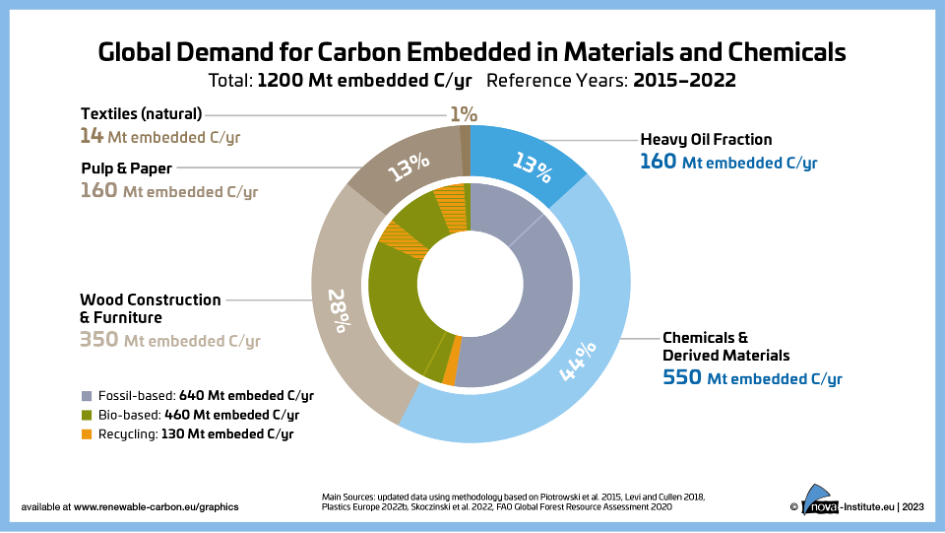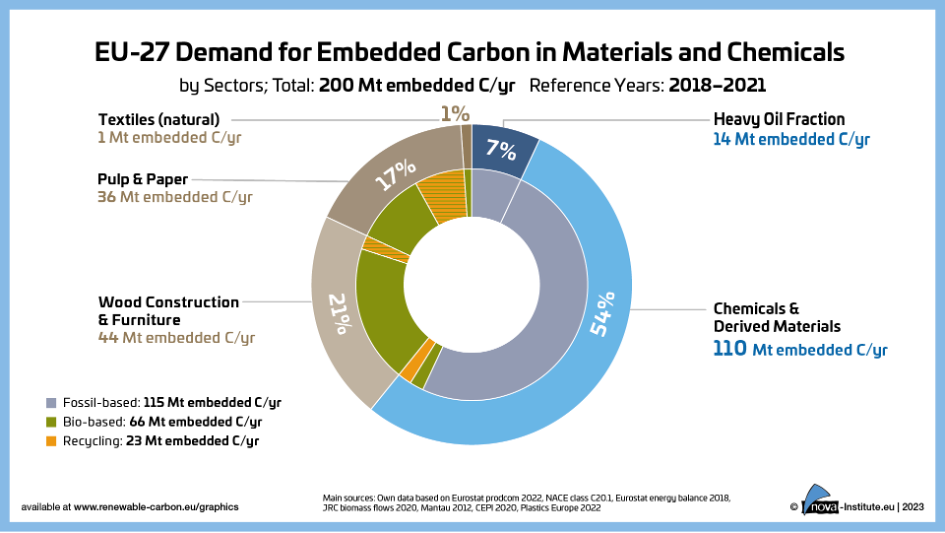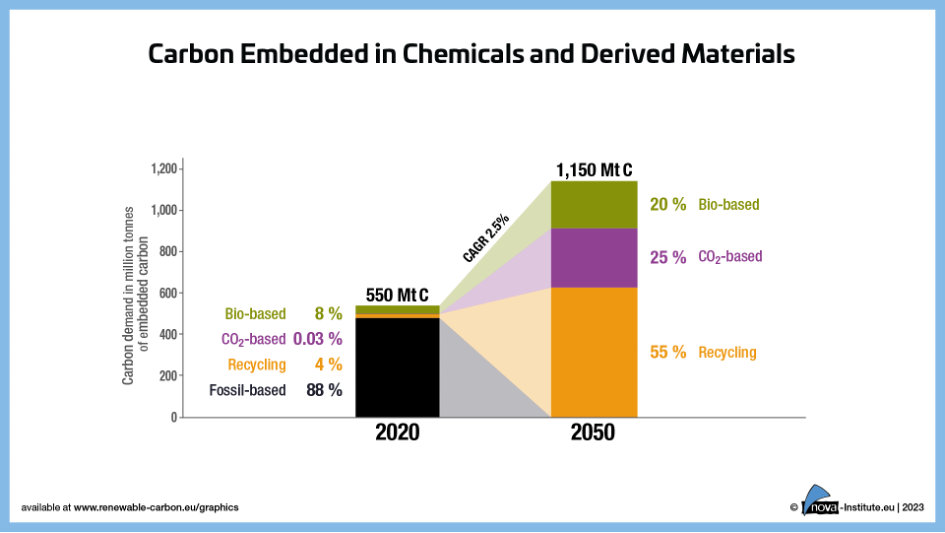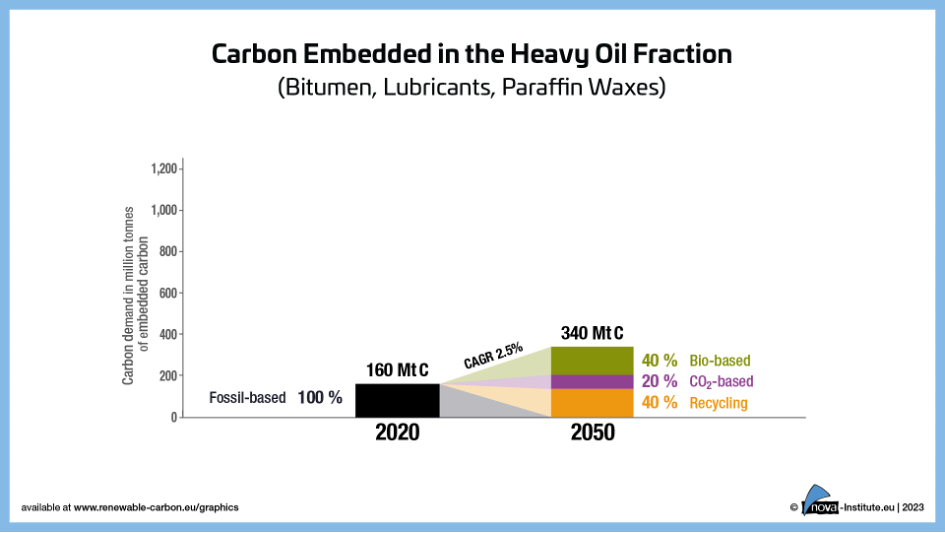In the last five years, the mindset around carbon has changed fundamentally. Of course, there is no way around the fact that the rising concentration of carbon dioxide in the atmosphere pose an existential threat to life on Earth. But at the same time, carbon is the main component of our food, the basis of all organic chemicals and plastics, and the backbone of life on Earth.
When it comes to carbon, the focus has long been on achieving a zero-carbon, decarbonised energy system wherever possible to avoid CO2 emissions. This is crucial and more urgent than ever to achieve net zero emissions by 2050. However, it is now becoming clear that other large volume sectors such as food and feed, but also all organic chemistry, plastics and significant parts of the materials sector are fundamentally and increasingly dependent on carbon. In the chemicals and plastics sectors in particular, almost 90% of the carbon used as feedstock is fossil carbon. This fossil carbon must be replaced by renewable carbon from recycling, biomass and CO2 by 2050 to avoid a further influx of fossil carbon into our technosphere and atmosphere.
Policymakers today are talking about “sustainable carbon cycles”, “defossilisation” and above all “carbon management”: which sectors should be supplied by which carbon sources in the future? To answer such complex questions and develop realistic targets and strategies, a resilient and comprehensive data basis on the carbon flows of all sectors, both globally and in Europe, has been missing until now.
The Renewable Carbon Initiative (RCI) has commissioned a study from the nova-Institute to fill this gap as best as possible. It builds on the nova-Institute’s long-standing work on biomass and carbon flows over the past 10 years and takes it to the next level. The result is a comprehensive, detailed and updated carbon flow data basis that significantly surpasses previous publications. All data have been corroborated as best as currently possible by scientific publications, feedback from experts and additional research. Remaining gaps and differences are transparently depicted and explained as well as possible.
The nova experts assessed data from a multitude of sources. A wide range of data on material flow are used to compile a comprehensive inventory of carbon stocks and flows. The sectors covered include all applications of organic carbon from fossil resources and biomass production, from raw materials through utilisation to final end-of-life. This includes use of carbon for feed and food, for materials, for energy and for fuels. A special focus is put on the carbon demand in the chemical and plastic industry today and tomorrow, with several figures specifically zooming into this sector and including scenarios for a full defossilisation by 2050.
If you have read previous reports on carbon flows and shares, you will find a number of data in this new report that differ from previous publications – ours or those of other authors. For example, the share of biomass in chemical feedstocks is lower than in previous publications. The figures have changed mainly because nova experts were able to gain particularly deep insights into the data and because we consulted many experts and associations for their input and feedback – thankfully possible due to the financial budget of the Renewable Carbon Initiative (RCI). One central aim was to generate a data basis as uniform and transparent as possible, so that it can then be used and shared by industry, associations and politicians alike.
The Carbon Flows report is designed to be a living document that we would like to update every one to two years if possible. This also means that we look forward to your feedback, additional input, new data and suggestions from any interested party. Please directly contact the main author of the study for this: ferdinand.kaehler@nova-institut.de
The report contains in total 80 pages with more than 35 graphics and tables plus corresponding descriptions of methodology, source material and data as well as five pages of literature sources. The format of the report allows to easily present the graphics to any audience.
You can download the full report free of charge including all visuals here: https://renewable-carbon.eu/publications/product/the-renewable-carbon-initiatives-carbon-flows-report-pdf/
The RCI commissioned a study from nova-Institute to compile a comprehensive inventory of carbon stocks and flows. All sources of organic carbon used in economic activities and all sectors where resources containing organic carbon are used are covered. The sources of carbon include the fossil resources, oil, gas and coal, as well as renewable carbon sources, namely biomass, recycling and CO₂, where already in use. The report determines the share of fossil carbon at 63%, while biomass contributes 35% and recycling 2% to the entire global supply of organic carbon. In Europe, the fossil share is even higher with 67%. Sectors that rely on organic carbon include food and feed, the material and chemical sector and energy and transport. The report presents material flow data for all these manifold sectors and determines the corresponding flows of carbon.
Carbon can be used in fundamentally different ways. On the one hand, it is used as energy carrier where the energy stored in the molecules of hydrocarbons is released in combustion processes for power generation or for transport. On the other hand, there are applications where carbon is embedded in the final product as a fundamental part. These include food and feed as well as the material and chemical sectors, where hydrocarbons are used or converted to form often complex chemical molecules. The material sector includes wood for construction and furniture, paper, cotton for textiles, and fossil and renewable carbon for a wide range of chemicals and plastics.
While the energy and transport sector can and should be decarbonised using renewable energy, electrification and hydrogen, carbon cannot be replaced in food and material applications. The material sector can only be defossilised, meaning a shift from fossil to renewable carbon sources. In the report, the renewable carbon share of carbon embedded in materials and chemicals is calculated to a remarkably high figure of 48% (37% from primary biomass, 11% from recycling) at world level and 4% at the European level (see figure 1 & 2). The material use of renewable carbon is dominated by wood for construction and furniture as well as pulp and paper. These two sectors are large and consume significant amounts of carbon in form of primary biomass but also non-negligible shares of recycled bio-based products. On the other hand, the chemical industry uses only small shares of biogenic carbon and carbon from recycling (6 and 3% globally and 4 and 3% in the EU).
Zooming in on the chemical industry, it still strongly depends on fossil carbon as raw material feedstock with more than 90% fossil carbon share, both globally and in the EU. When compared to other statistics, this figure is surprisingly high, but in the RCI’s report the heavy oil fraction (mainly bitumen) is included for the first time – an application sector exclusively consuming fossil carbon so far.


In the report, comprehensive depictions of current supply of carbon are drawn. An in-depth analysis is carried out for the chemical sector. Next to the carbon contained in energy carriers that is used in the chemical industry, an additional annual demand of 710 megatons of carbon (Mt C) is embedded in feedstock used for material purposes. The sub-sector of chemicals and derived materials currently uses 88% fossil feedstock.
From this point, the authors outline an explorative scenario for 2050 that considers a growing demand due to rising consumption of chemicals and plastics and rising demand for road infrastructure on the one hand. On the other hand, the scenario is based on a complete phase-out of fossil feedstock and a shift to renewable sources of carbon. For chemicals and derived materials, a share of 55 % is assumed based on ambitious exploitation of both mechanical and advanced recycling. But recycling alone cannot completely close the carbon cycle, additional carbon must be fed into the circular carbon flow. In the explorative scenario, biomass is required to meet the demand for chemicals and derived materials but the share is limited to 20% due to constrained limited availability of agricultural and forestry areas as well as biodiversity loss. The remaining share of 25% is provided by Carbon Capture and Utilisation (CCU) technologies, using CO2 emissions from fossil and biogenic point sources and direct air capture.


The collected data emphasise the dependence of the energy and transport sector on fossil sources of carbon. Furthermore, the data can be used as a basis for the material sector to phase out fossil carbon, a process referred to as defossilisation. The information can set the basis to shape the future distribution of renewable carbon sources for the feed and food, material and chemical and energy and transport sectors: a comprehensive carbon management across all sectors.
Contact
Ferdinand Kähler
Expert for Sustainability at nova-Institute
E-Mail: ferdinand.kaehler@nova-institut.de
About RCI
RCI members are a diverse group of companies, institutions and associations addressing the challenges of the transition to renewable carbon with different approaches. The opinions expressed in this press release may not necessarily reflect the policies and views of all RCI members. The RCI is not responsible for any use that may be made of the information it contains.The Renewable Carbon Initiative (RCI) was founded in September 2020 by eleven leading companies from six countries under the leadership of nova-Institute (Germany). The aim of the initiative is to support and speed up the transition from fossil carbon to renewable carbon for all organic chemicals and materials.
Download visuals free for press purposes as well as this press release in multiple languages at https://renewable-carbon-initiative.com/media/press/?id=417
Source
Renewable Carbon Initiative, press release, 2023-03-16.
Supplier
nova-Institut GmbH
Renewable Carbon Initiative (RCI)
Share
Renewable Carbon News – Daily Newsletter
Subscribe to our daily email newsletter – the world's leading newsletter on renewable materials and chemicals













